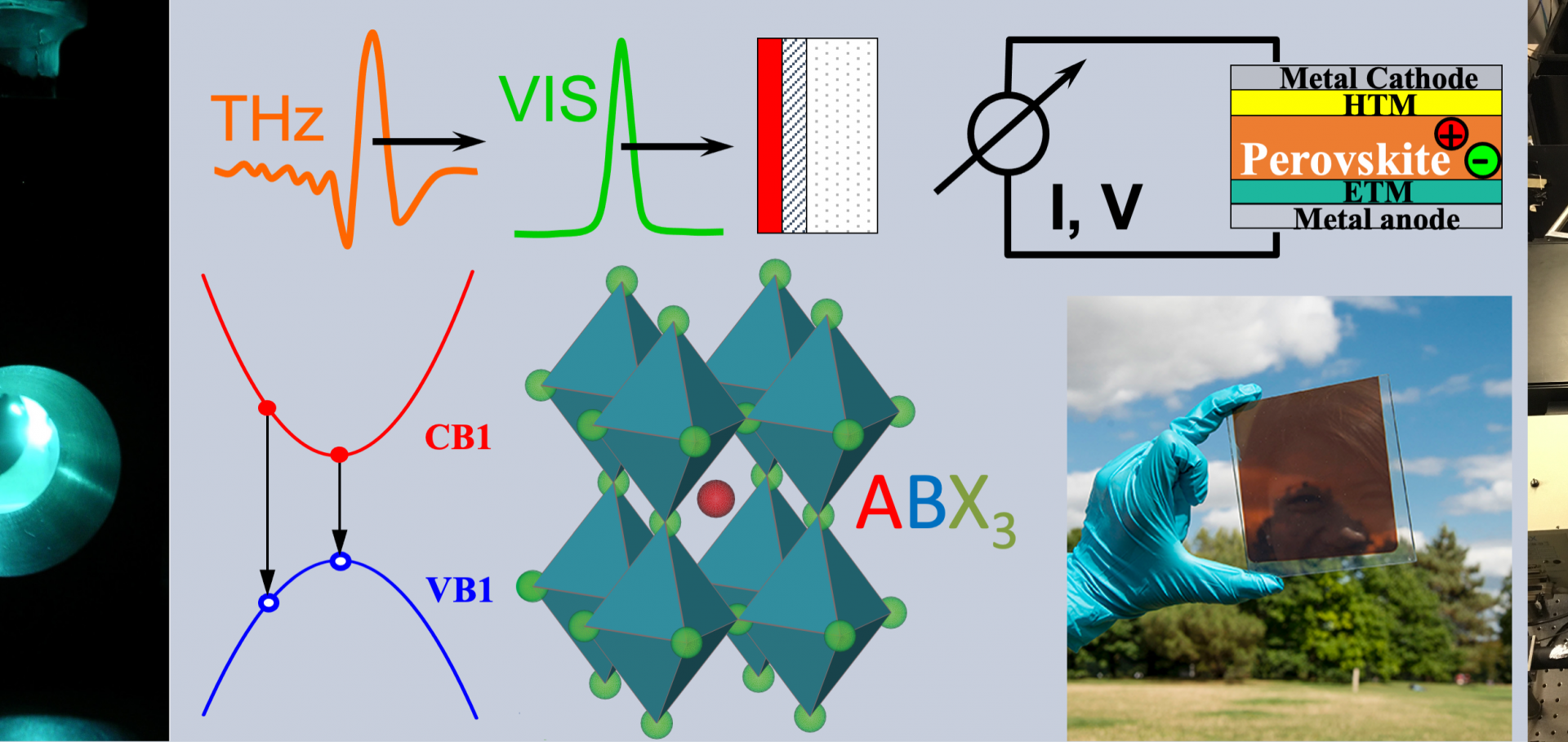Oriented naphthalene-O-propylammonium-based (NOP)4AuBIIII8 (B = Au, Bi, Sb) Ruddlesden–Popper two-dimensional gold double perovskite thin films featuring high charge-carrier mobility
Journal of the American Chemical Society American Chemical Society 147:20 (2025) 16992-17001
Abstract:
Two-dimensional perovskites show intriguing optoelectronic properties due to their anisotropic structure and multiple quantum well structure. Here, we report the first three gold-based Ruddlesden–Popper type two-dimensional double perovskites with a general formula (NOP)4AuIBIIII8 (B = Au, Bi, Sb) employing naphthalene-O-propylammonium (NOP) as an organic cation. They were found to form highly crystalline thin films on various substrates, predominantly oriented in the [001] direction featuring continuous, crack-free film areas on the μm2 scale. The thin films show strong optical absorption in the visible region, with band gap energies between 1.48 and 2.32 eV. Density functional theory calculations support the experimentally obtained band gap energies and predict high charge-carrier mobilities and effective charge separation. A comprehensive study with time-resolved microwave conductivity (TRMC) and optical-pump-THz-probe (OPTP) spectroscopy revealed high charge-carrier mobilities for lead-free two-dimensional perovskites of 4.0 ± 0.2 cm2(V s)−1 and charge-carrier lifetimes in the range of μs. Photoconductivity measurements under 1 sun illumination demonstrated the material’s application as a photodetector, showing a 2-fold increase in conductivity when exposed to light.Interdiffusion control in sequentially evaporated organic–inorganic perovskite solar cells †
EES Solar Royal Society of Chemistry (2025)
Abstract:
Vacuum deposition of metal halide perovskite is a scalable and adaptable method. In this study, we adopt sequential evaporation to form the perovskite layer and reveal how the relative humidity during the annealing step, impacts its crystallinity and the photoluminescence quantum yield (PLQY). By controlling the humidity, we achieved a significant enhancement of 50 times in PLQY from 0.12% to 6%. This improvement corresponds to an increase in implied open-circuit voltage (Voc) of over 100 meV. We investigate the origin of this enhanced PLQY by combining structural, chemical and spectroscopic methods. Our results show that annealing in a controlled humid environment improves the organic and inorganic halides' interdiffusion throughout the bulk, which in turn significantly reduces non-radiative recombination both in the bulk and at the interfaces with the charge transport layers, which enhanced both the attainable open-circuit voltage and the charge carrier diffusion length. We further demonstrate that the enhanced intermixing results in fully vacuum-deposited FA0.85Cs0.15Pb(IxCl1−x)3 p-i-n perovskite solar cells (PSCs) with a maximum power point tracked efficiency of 21.0% under simulated air mass (AM) 1.5G 100 mW cm−2 irradiance. Additionally, controlled humidity annealed PSCs exhibit superior stability when aged under full spectrum simulated solar illumination at 85 °C and in open-circuit conditions.The promise of operational stability in pnictogen-based perovskite-inspired solar cells †
EES Solar Royal Society of Chemistry (2025)
Abstract:
Perovskite-inspired materials (PIMs) are gaining increasing attention among emerging photovoltaic absorbers due to their inherent air stability and low-toxicity potential. However, operational stability, the Achilles' heel of all emerging photovoltaics, has been largely overlooked in PIMs research so far, making it difficult to forecast their practical use in real-world applications. In this work, we analyse the operational stability of a promising new PIM composition, CsMAFA-Sb:Bi, generated through the antimony : bismuth co-alloying of a triple cation vacancy-ordered antimony-based PIM. Through an in-depth theoretical and experimental investigation, we demonstrate that the co-alloying induces local structural changes that lead to enhanced microstructure, reduced trap-assisted recombination, and increased solar cell power conversion efficiency (PCE), with the highest value being 3.05%. Accelerated aging tests according to ISOS L-1 and L-2 protocols highlight the crucial role of co-alloying in enhancing stability. Specifically, maximum power point tracking at 85 °C shows a projected T80 lifetime of 275 hours for CsMAFA-Sb:Bi devices, which has never been achieved not only for any other PIM-based device but also for high-efficiency technologies, such as lead halide perovskite solar cells with similar device constituents. This work encourages future studies on PIM-based photovoltaics for their potential operational stability, with the goal of reducing the performance gap with established technologies.Aerosol-Assisted Crystallization Lowers Intrinsic Quantum Confinement and Improves Optoelectronic Performance in FAPbI 3 Films
The Journal of Physical Chemistry Letters American Chemical Society 16:9 (2025) 2212-2222
Abstract:
FAPbI3 has emerged as a promising semiconductor for photovoltaic applications offering a suitable bandgap for single-junction cells and high chemical stability. However, device efficiency is negatively affected by intrinsic quantum confinement (QC) effects that manifest as additional peaks in the absorption spectra. Here, we show that aerosol-assisted crystallization is an effective method to improve crystallinity and suppresses regions exhibiting QC in FAPbI3. We demonstrate that films with minimized QC effects exhibit markedly enhanced optoelectronic properties, such as higher charge-carrier mobilities and recombination lifetimes. Films crystallized under an aerosol solvent flow of either a mixture of N, N-dimethylformamide and dimethyl sulfoxide or methylammonium thiocyanate vapor displayed reduced charge-carrier recombination losses and improved diffusion lengths compared to those of thermally annealed control films. Our study indicates clear correlations between suppression of QC features in absorption spectra with optimization of crystallinity and mitigation of internal strain, highlighting pathways toward high-performance solar cells.Inter‐Layer Diffusion of Excitations in 2D Perovskites Revealed by Photoluminescence Reabsorption
Advanced Functional Materials Wiley (2025) 2421817


